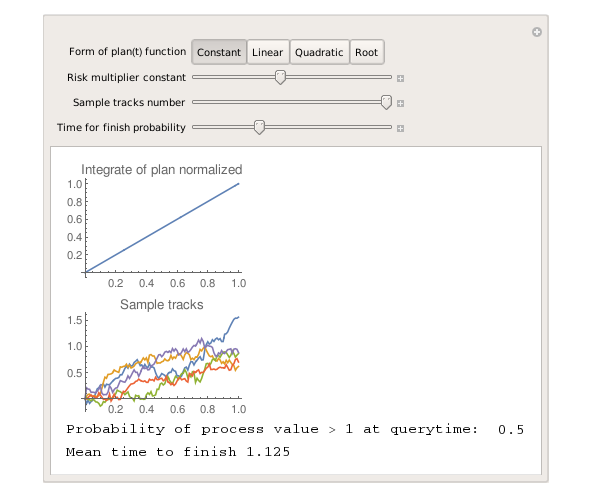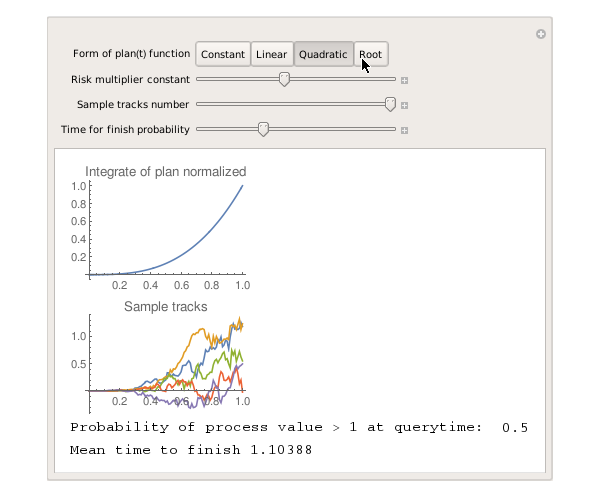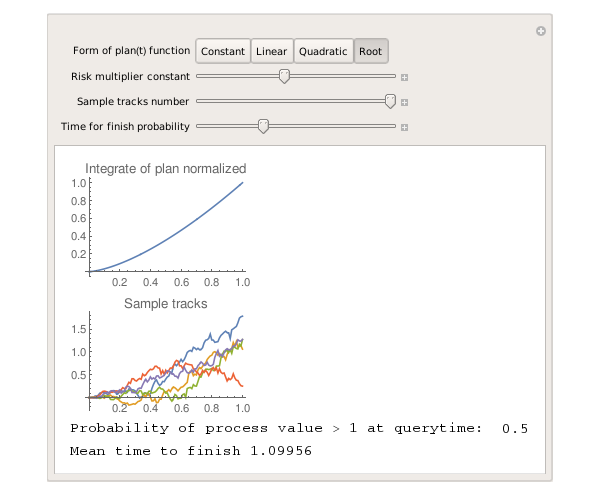Progress of an abstract project in a vacuum: a random process model
Good day everyone. In the comments to the post Waterfall and Agile: and yet, where did the effect come from? wishes were expressed to model the course of projects. I’ll say right away that I don’t have enough of me for more than the articles in the “note on napkins” genre, but nevertheless, the interesting and trivial Wolfram Mathematica theme is available and can work with stochastic differential equations. For example:
d progress (t) = plan (t) * d t + risk (t) * d w t
In this short post, specific plan and risk will be substituted. Immediately I say, there will be no special miracles.
plan (t) is the speed of progress in time
Risk (t) is a (negative) speed supplement designed to reflect delays in the execution of tasks, the emergence of new tasks and in general all sorts of problems. Further, the risk will be equal to -riskconstant * plan (t), where the first factor, some value, is greater than zero and less than one.
progress (t) is the function itself, reflecting the level of project implementation (the initial value is 0, we will be interested in the value 1, corresponding to one hundred percent).
And then, looking into the equation, we can say.
Based on the equation, the obvious conclusion, but in practice ... it does not always think about it.
The most interesting is the average time when the process will be more than one. To calculate this, you have to use the theory ( this one ).
')
Let's get down to business and do some research. The basis will be taken four functions of the plan: constant speed, with linear growth, quadratic function and square root.
The table shows screenshots (Wolfram Trial Mathematics has broken off with export) results for risk constant = 0.5 and time to check completion = 1.
And what conclusions can we draw here? Yes, especially you can’t do anything, except that control without feedback (that is, without participation progress (t) in the right side of the equation) is doomed if there are risks to have a delay on average. And yes. Where do not shift the progress within the project (well, that is, initially, do not move the risks forward or backward), with a probability of 0.5 you will be in time (the 0.5 is not directly related to riskconstant = 0.5, in this case this is a coincidence).
CDF (for version 10.0) can be downloaded here .
PS Find errors - write urgently, until the trial is over :) After three weeks, the carriage will turn into a pumpkin.
PPS Regarding rac. sentences are the same: what if someone advises a specific feedback equation, or something like that.
d progress (t) = plan (t) * d t + risk (t) * d w t
In this short post, specific plan and risk will be substituted. Immediately I say, there will be no special miracles.
plan (t) is the speed of progress in time
Risk (t) is a (negative) speed supplement designed to reflect delays in the execution of tasks, the emergence of new tasks and in general all sorts of problems. Further, the risk will be equal to -riskconstant * plan (t), where the first factor, some value, is greater than zero and less than one.
progress (t) is the function itself, reflecting the level of project implementation (the initial value is 0, we will be interested in the value 1, corresponding to one hundred percent).
And then, looking into the equation, we can say.
| To complete the project, it is necessary that the risk of losing progress is not always greater than the growth of progress! |
Based on the equation, the obvious conclusion, but in practice ... it does not always think about it.
The most interesting is the average time when the process will be more than one. To calculate this, you have to use the theory ( this one ).
')
Let's get down to business and do some research. The basis will be taken four functions of the plan: constant speed, with linear growth, quadratic function and square root.
The table shows screenshots (Wolfram Trial Mathematics has broken off with export) results for risk constant = 0.5 and time to check completion = 1.
| Constant function |  |
| Linear function |  |
| Quadratic function |  |
| Root function |  |
And what conclusions can we draw here? Yes, especially you can’t do anything, except that control without feedback (that is, without participation progress (t) in the right side of the equation) is doomed if there are risks to have a delay on average. And yes. Where do not shift the progress within the project (well, that is, initially, do not move the risks forward or backward), with a probability of 0.5 you will be in time (the 0.5 is not directly related to riskconstant = 0.5, in this case this is a coincidence).
CDF (for version 10.0) can be downloaded here .
PS Find errors - write urgently, until the trial is over :) After three weeks, the carriage will turn into a pumpkin.
PPS Regarding rac. sentences are the same: what if someone advises a specific feedback equation, or something like that.
Source: https://habr.com/ru/post/237729/
All Articles